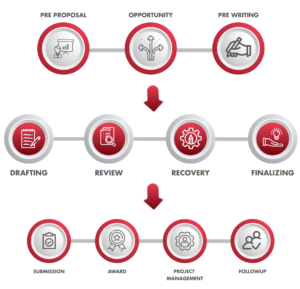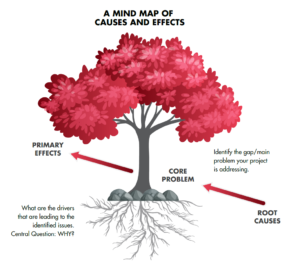TA-Area
THIS SPACE IS WHERE TECHNICAL ADVISORS FIND ALL THE RELEVANT INFORMATION FOR THEIR ASSIGNMENTS.
THIS SPACE IS WHERE TECHNICAL ADVISORS FIND ALL THE RELEVANT INFORMATION FOR THEIR ASSIGNMENTS.
Grant fundraising refers to funds generated from grant funders, such as official development bodies, foundations or other sources. Grant fundraising can be highly effective when the organisation has the capacity and resources to develop high-level, winning proposals. Most grants fund a specific project running over a certain period of time, activities and related management and M&E tasks, while organisational grants or grant elements also support organisational development and capacity building. However, due to the project funding nature, it is not common to get organisational core funding through a grant.
Many times, a grant funding process is divided into a concept and a full proposal stage. When an organisation’s proposition put forward in the concept has been approved, a full project proposal has to be developed and will again be assessed.
If the proposal has been accepted for funding, project set-up clarification and negotiation meetings with the donor will be held to finalize the logframe, budget and other documents guiding the implementation and Monitoring, Evaluation and Learning (MEL) of the project.

Source: Spear, T. (2013), 7stages of a business proposal life cycle. Online at https://blog.quoteroller.com/7-stages-business-proposal-lifecy-cle/ , accessed 7/10/2020.
There are a number of steps to follow to secure project grants and usually several months pass from the development of a concept until the project is implemented and the donor relationship cultivated with timely and high-level reporting. Grant fundraising steps include:
During the pre-proposal stage the organisation on the one hand looks out for funding opportunities by reviewing upcoming calls and engaging with potential resource partners (see section 4: Communication Strategies).
Resource partners may put out calls where any organisation meeting the requirements can apply and solicit proposals formally on their website and other channels. Other funders want to know the potential organisations they might be supporting first and only accept proposals upon invitation. With those, it is particularly important to work on establishing a relationship to receive the opportunity to submit a grant in the future.
Organisations may also decide to send an unsolicited proposal when they see good chances to interest donors with their proposal. Other than that, existing grants may be continued beyond the timespan originally planned, renewed after the project duration or supplemental funds may be granted because the circumstances warrant the need.
A potential resource partner monitoring calendar can help to keep an overview of the organisational strategy with different donors, grant opportunities recurring annually and other deadlines and to plan for proposal development and other donor engagement activities.
Tool: Potential Resource Partner Monitoring
Furthermore, it is important to organise to have the organisational documentation ready: registration certificate, financial and organisational audit reports of the past 3 years, short bios of key staff, a summary of recently completed and ongoing projects, reports where you have documented the success of your approaches and learnings, information on the districts or regions of implementation to support the problem you will be addressing with your work. Having this information ready will ease the development of your concept or project proposal and also the provision of the supporting documents required for the application submission.
When a funding call has come up, it is important to examine it thoroughly whether it suits the organisational goals, cause and activities as well as to understand whether the organisation fulfills the award requirements of the grant.
Reflect on the donor’s funding interest and priorities whether they match with your organisation’s mission and vision and programmatic activities. Funding criteria may also include the time how long the organisation has been operational, regional or national funding restrictions, other factors to consider are how much funding can be requested in relation to the organisational budget and to note the deadlines and process for the application (concept and full proposal stage or just proposal submission).
Consider whether the project will be best implemented in a partnership, building on relationships with other organisations. Signing a memorandum of understanding (MOU) when forming a consortium can help to ascertain commitment, roles and responsibilities of the parties during the project development and implementation.
Most donors make themselves available to answer questions in a session or until a certain date before the deadline. Use such opportunities to get any clarifications you may need to come up with a strong project proposition.
Before you start the actual proposal writing, as a first step develop the proposition you want to get funded. Plan enough time to collect information and plan the project before you commence with the write-up. Also, ensure the availability of management and the finance team for input and consultation on the proposed project as well as for budget development and approval.
As a first step, gather information on the problem by consulting stakeholders, anyone affected by, or with an interest in the project, to help you develop a clear, concise understanding of the problem or situation. They will also be the best sources to inform you which solutions will best work to address the problem and to create an effective intervention.
In addition to the voices of stakeholders, strong data and information and from research, government statistics and experts, as specific to your intervention as possible, will help you strengthen the case for support. Make sure to set time aside for desk review and data collection from experts, government bodies or other accepted sources of information which provide insight into your problem and response.
Based on a sound understanding of the situation, define the core problem your intervention will address. A problem tree is a helpful exercise to create a mind map of the causes and effects of an issue since it helps to identify the gap and problem that will be tackled. Focusing on the core problem, investigate the root causes of the issue as well as the impact and effects on the project participants.

Source: Oliver, E. (n.d.). Let’s explore. Hop into the roots of a plant. Online at: http://letsplant.yolasite.com/, accessed 7/10/2020. Changes made by authors.
With the team in your organisation, discuss how the intervention will aim to solve the root causes of the problem through the activities to be undertaken. Formulate the long-term change you want so see in the community in your project goal and determine the best, creative path of how you plan to get there. In an intervention logic (logframe, theory of change, etc.) layout the project goal, outcomes, outputs and activities. The outputs reflect the results of the project’s activities and the outcome(s) talks about the change which will be achieved in the community through the intervention.
Ensure that the projected outcomes are realistic and contribute to the achievement of your project goal. Setting goals too high and failing to meet them, will make the donor question the organisation’s capability, while underestimating what can be achieved may make the project appear cost-ineffective.
Also think about how you will make the effects of your work measurable and when you plan to achieve them so you can come up with milestones.
Once the activities have been agreed upon, you can start work on the budget.
As a next step, the actual proposal writing can start. The concept or proposal will usually be drafted by a team or assigned person who will take lead on the process. It will then be reviewed and the organisational feedback integrated before the document is finalized and ready for submission. Plan well ahead for this process and allow enough time for multiple drafts and reviews by others.
The actual proposal writing can be done by one person or be split between the team, however, ensure that one person coordinates the members and compiles the final document. Read the grant call carefully and follow the instructions for the write-up on the different sections. Answer all questions and remember to KISS – keep it smart and simple!
These are the sections required in most proposals:
Give the relevant team members enough time to review the draft proposal and to give you feedback on how to improve the write-up to ensure it clearly explains your plans, speaks to the call and offers an engaging solution to the problem.
When the feedback has been received, integrate it and clean up the document. Allow enough time for the revision to address comments comprehensively.
After the integration of edits, proofread the document for its logic and to ascertain that all its elements complement and speak to each other. Make sure all donor requirements are covered and conduct a language, spelling and format check to bring the proposal to the highest standard when submitting.
Make sure you are aware of the exact submission deadline and timing, including time differences if you are submitting to an international donor. Also, check out the submission format and channel and prepare to hand in well in time to mitigate potential technical glitches. Ensure you have all supporting documents required by the donor ready for uploading, e.g. budget, logframe or theory of change, audits, registration, wire transfer form).
Once the document has been submitted, the waiting begins to hear back from the donor whether the concept has made it to the full proposal stage or whether the proposal has been approved.
After the award has been celebrated, there will be an exchange between grant giver and grantee to fine tune the project documents, logframe, and budget. Additionally, the organisational policies and governance structures will usually be reviewed to ensure that they fulfill donor requirements.
As a next step a contract explaining the legal framework of the project will be drawn up and signed.
Once the project has started, it follows the management cycle of activity implementation, monitoring and learning activities and reporting about what has been achieved.
Acquaint yourself with the donor reporting guidelines and the reporting times, both financial and activity-based. Plan well in advance to put together the required information and submit in time.
In case you encounter severe issues concerning the implementation of activities or other problems, which require changes to the project, communicate to the donor even out of the reporting times, so they understand your situation.